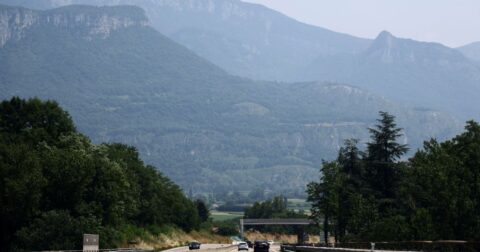Is New York City Getting its Composting Program Right?
Climate•10 min read
Feature
Cattle ranching fuels climate pollution, but its land-clearing effects can also make wildfires more likely to spread.


Words by Jessica Scott-Reid
As I write this, smoke hangs in the air around my house. The fires are hundreds of miles away, but the smoke still reaches my city, where thousands of residents from north of the province of Manitoba are headed to escape the wildfires inching toward their homes. We remain under a state of emergency as over 1.4 million acres of land continue to burn.
It’s wildfire season in North America, something that has long occurred as part of natural weather patterns. But over the last two decades, these fires have become more frequent and intense. Much like the fires that devastated California earlier this year, and killed and displaced billions of animals in Australia, the dozens of wildfires sweeping across Canada today are part of a decade-long trend of unprecedented fire seasons.
“Increased wildfires are an inevitable part of climate change,” Cathy Whitlock, regents professor emerita of Earth Sciences at Montana State University, tells Sentient, “and until we reduce greenhouse gas emissions, we are going to continue to see large, fast-growing fires in the face of rising temperatures and drought.”
Yet denial about the connection between wildfires and climate change persists. A commenter on Instagram calls the fires a natural and “necessary restoration” of the forest. Others blame arsonists or the government for starting the fires. This kind of misinformation has consequences. “Wildfire misinformation creates risk,” says Whitlock, “for people, property and natural ecosystems.”
The evidence is clear that climate change has made wildfires more intense and frequent. And the meat we eat — especially beef — is part of that equation, because meat consumption also drives climate change. Livestock production is one of the top contributors of planet-warming greenhouse gas emissions, a major cause of deforestation and of land and fresh water use — all of which exacerbate conditions for devastating wildfires. Wildfires themselves have climate consequences as well — “almost a decade’s worth of carbon emissions” have been recorded in a single fire season in Canada.
A 2023 report by the Organization for Economic Co-operation and Development (OECD), on wildfires and climate change looked at wildfires in Canada in 2017, the 2018 Camp Fire in California and wildfires in Australia from 2019 to 2020, and found all had greater impacts as a result of climate change. The link between climate pollution and wildfire impacts are clear, the report found: “human-induced ecosystem degradation is a key driver behind growing wildfire risk.”
The likelihood of extreme weather conditions, like those that fueled Australia’s 2019 wildfires, has risen by at least 30 percent since 1900, according to a 2020 analysis conducted by World Weather Attribution, making fire conditions at least four times more common than they were a century ago. What’s more, the authors caution this is likely a conservative estimate.
Still, myths and misinformation about the connection between wildfires and climate change persist, due in part to political rhetoric and reversal of previous climate policies, as well as the ease with which climate change denial has spread on social media and popular podcasts.
What might make the misinformation more compelling is there is a grain of truth. “Of course wildfires are natural,” explains Whitlock. “They’ve happened for millions of years, and they’re part of the ecosystems that most of us live in. It’s the way that forests change and get disturbed and regenerate.”
But that’s not the whole picture, she says. “What we’re seeing now is unusual in Earth history. The fires are extremely large,” at a size and rate of growth that she calls “unprecedented.” And while she explains that fires can start in a number of ways, from lightning to volcanic eruptions, powerlines to human ignition, “not all fires that start become big fires. That’s the climate part.”
Climate change impacts wildfires directly, adds Whitlock, because “it’s very, very warm, and that makes the air very dry.” There is a saying she shares, “‘When the air is dry, it’s thirsty,’ and so it really kind of sucks the moisture out of the vegetation and out of the soil, which makes those things very, very dry and extremely flammable” — the perfect environment for fires.
“Then you have fire weather, which are the particular conditions of the day, strong winds, extreme temperatures — all the conditions that let fire spread and that allow the fires to become quite large.”
Climate change is caused by a number of human activities, including the way we eat. Around a third of global greenhouse gas emissions come from food, mostly driven by meat — especially beef.
Beef is a leading driver of deforestation, and drought conditions coupled with this land clearing help create “fuels,” says Whitlock. When you have fuels, “then you have fire.” In some regions, she explains, “deforestation opens up the canopy and makes it drier. In some cases, after forests are cleared, then you get this shrub layer that provides fuel connection and allows the fires to spread.”
Cattle ranching, when not properly managed, can lead to overgrazing and the spread of non-native vegetation. In both the U.S. and Canada, cattle overgrazing has degraded native grasslands, making way for highly flammable invasive grasses like cheatgrass in the U.S. and Kentucky bluegrass in Canada. These species dry out early, ignite easily and spread quickly, forming a destructive cycle in which each wildfire clears the way for more invasives and fewer fire-resistant native plants. A decade ago, livestock were even identified by the U.S. Bureau of Land Management as a vector for the spread of these flammable grasses on public land.
Mitigating wildfire risk and fighting climate change go hand-in-hand. According to Whitlock, “Anytime that it’s warm, we get more fires. And so anything we can do to reduce global warming is going to help reduce fires. It’s just that simple.”
Reducing our impact on the planet, and lowering our contribution to wildfire risk takes both collective and individual action. But for the latter, Project Drawdown has found that eating more plants is one of the most effective forms of individual climate action.
As I write this, I can feel a faint sense of burning in my chest. Latest reports show there are 83 uncontrolled wildfires currently burning in Canada. Yet the posts I’m seeing on social media are rife with climate change denial and misinformation. If we’re going to do better at protecting the planet, we need to get savvier about the media we consume, and start talking more about the amount of meat we keep eating.